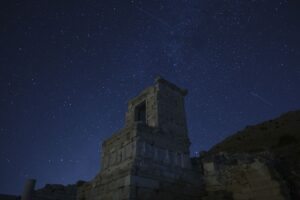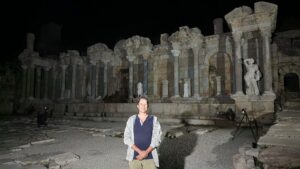
One of the most spectacular celestial events of the year, the Perseid Meteor Shower, created a visual feast for photographers in the ancient cities of Sagalassos and Kibyra in the region of Pisidia. Peter Talloen, Chair of the Department of Archaeology and director of excavations at Sagalassos, watched this unique sky spectacle with his team in front of the Antonine Fountain. He remarked, “Watching such events in the ancient city makes us feel as if the city has come back to life.”
The Perseid meteor shower, which occurs every August as particles left by the Swift-Tuttle comet enter Earth’s atmosphere, can be easily observed from locations free of light pollution. On August 12-13, when 90 to 100 meteors can be seen per minute, photographers and citizens alike stay up late to enjoy this visual spectacle.
Dr. Talloen shared insights in his statement: “I have been working on the Sagalassos excavation since 1995. I first came here as a student and later completed my undergraduate, master’s, and doctoral studies. Since last year, in 2023, I have been serving as the excavation director. Sagalassos is one of the most important cities in the Lakes Region of the Pisidia area. This year’s excavation began on July 1, and we will continue our research here until the end of September.
Sagalassos was a major city of the ancient world, significant for Pisidia, but with a population of only around 3,500 to a maximum of 5,000 people. We are fortunate in our work here because a massive earthquake occurred in the 7th century AD. A fault line already ran through the city, and we know the epicenter was here. That earthquake nearly destroyed this ancient city. Afterward, much of the city—particularly the monumental center—was abandoned, and everything remained buried under soil and rubble. As a result, we are able to uncover and restore the buildings and spaces from that period. In this respect, Sagalassos is unique.
Moreover, we don’t only investigate the city itself but also its surrounding territory. Sagalassos’s territory is extensive, covering an area of about 1,200 square kilometers. We examine the farms and villages there, studying their economic activities and agricultural practices. For instance, we’ve learned that they produced both olive oil and wine, revealing the financial resources that allowed this small city to make such a monumental impression.”
Dr. Talloen went on to note that “Watching such a natural phenomenon amid these ancient structures is truly enjoyable, and we try to share this experience with the students as much as possible. It creates a wonderful atmosphere for the team, with participants from both Turkey and other countries. In this way, we breathe a bit of life into these ancient remains. Everyone usually sees them as old stones, but when we gather together for such events, it feels as though ancient life partially revives. Some students are here for the first time, including international ones, who may know of Ephesus or Pergamon but are unaware of cities like these deep within Anatolia.
Throughout the season, we live within the village and build relationships with the local community. Students go to the market and visit tea gardens—it’s a warm and welcoming environment. We hope they carry these stories abroad, sharing their experiences with family and friends. This way, tourists won’t only stay along the coast; they’ll also visit Central Anatolia. If we can contribute to that in some way, we’re very happy.”
Source: Kağan Onaran, “Antik kentlerde perseid meteor yağmuru, görsel şölen büyüledi”, [NNC Haber](https://www.nnchaber.com/antik-kentlerde-perseid-meteor-yagmuru-gorsel-solen-buyuledi), 13.08.2024
Photographers: Cem Yıldırım and Nazım Özdemir